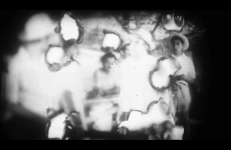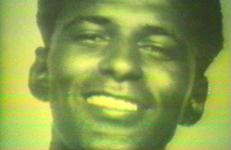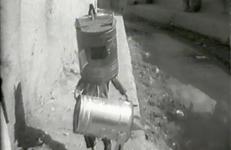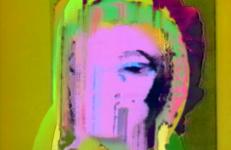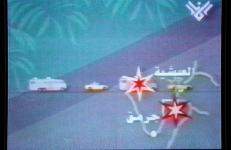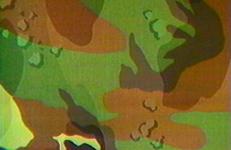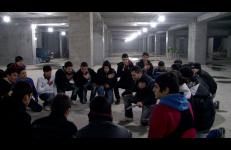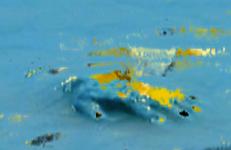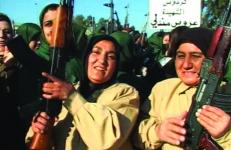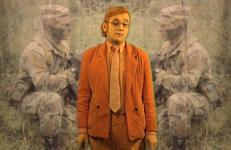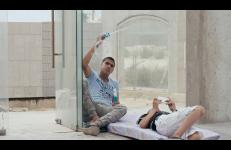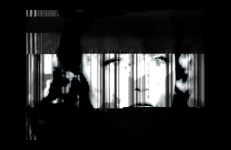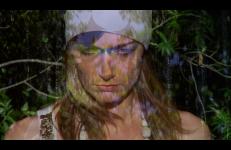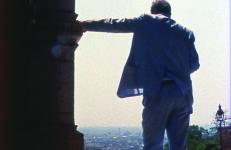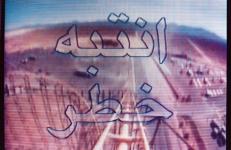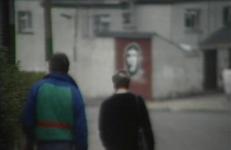Through poetic juxtaposition of the virtual landscape of the phone, the calm landscape of the cabin, and the chaotic landscape of memory, 1991 paints a cruel image of the horror of war and separation.
War
Anthony Ramos' astute deconstruction of television news focuses on his part in the media coverage of President Jimmy Carter's 1977 declaration of amnesty for Vietnam draft evaders. Ramos, who had served an 18-month prison sentence for draft evasion, was interviewed by news reporter Gabe Pressman, whose film crew meets Ramos' video crew in a confrontation between technologies and sensibilities. At the time, some broadcast television news crews still used 16mm film, although the expensive transition to ENG (electronic news gathering) systems had begun in 1974.
In 1972 Eric Siegel, an early pioneer of video art, set out on an extreme adventure driving from Europe six thousand miles overland to India. He was one of the first people to use the revolutionary new technology from Sony Corporation, the Portapak. This was the first small portable video camera/recorder combo that was the predecessor of today’s camcorders. Together with his friend Anthony they documented the trip. This video is the portion of the trip that took them through Afghanistan, one of the most exotic places along the way.
An old Russian Akula submarine, armed with ballistic nuclear missiles, is assigned a new captain. But Captain Pavel seems to care very little for Navy protocol. In fact, he feels the crew’s jobs are a waste of time, preferring to lead discussions about spiritual matters. The Captain dresses in a cassock and grows a long beard. His favorite pastime is shamanic drumming, which even the confused American’s can hear from the ship.
Through collage, Alazeef shows the dreams and the fears of a typical Iraqi soldier, a week before the 1991 Desert Storm, compared to the huge war machine. Through poetic narration, Alazeef humanizes the "enemy" and separates the people and soldiers on both sides from political agendas. The control of the mise-en-scene gives the film a radiant surreal feeling.
One of Zaatari’s earliest experiments in documentary video, All Is Well on the Border emerged from the filmmaker’s desire to understand Israel’s occupation of Southern Lebanon following the 1982 Lebanon War. The video presents a series of testimonies by Lebanese citizens who were detained during the occupation, each presenting an image of resistance that falls outside the dominant narrative of liberation and solidarity promoted by the Lebanese left.
For four years in the 1860’s, half of the United States was held hostage by an unrecognized white supremacist republic. Shot on 16mm in national military parks, swamps, forests and the suburban sprawl across the former battlefields, the film follows General Grant’s path liberating the southern United States. Part travelogue, part essay film, part landscape documentary, it moves from the Texas-Louisiana border to a prison island off the coast of New England.
Q: What was the Cubists’ greatest contribution to modernity? A: The invention of camouflage. The Art of Protective Coloration asks us to consider the less-than-innocent connections between the making of art and the making of war. Such questions are the first few steps into the deceptively shifting terrain of this videotape, which leaps into a lurid meditation on aggressive male fantasies, linking the domains of art, war, and sex. It looks at binocular voyeurism, the regressive illusion of the perfected body (whether female or male), the phallic gun-toting pin-up, and camouflage.
Q: What was the Cubists’ greatest contribution to modernity? A: The invention of camouflage. The Art of Protective Coloration asks us to consider the less-than-innocent connections between the making of art and the making of war. Such questions are the first few steps into the deceptively shifting terrain of this videotape, which leaps into a lurid meditation on aggressive male fantasies, linking the domains of art, war, and sex. It looks at binocular voyeurism, the regressive illusion of the perfected body (whether female or male), the phallic gun-toting pin-up, and camouflage.
The Battle of Karbala (680) resulted in the death of Hussein, the grandson of prophet Muhammad and all his supporters. This battle is central to Shi'a Muslim belief in which the martyrdom of Hussein is mourned by an annual commemoration, Ashura. Artist Köken Ergun has worked with Istanbul's Shiite minority, documenting their preparations for the Ashura day.
Note: This title is intended by the artist to be viewed in High Definition. While DVD format is available to enable accessibility, VDB recommends presentation on Blu-ray or HD digital file.
Atomic Ed & the Black Hole tells the story of a scientist-turned-atomic junk collector known as Atomic Ed. More than 30 years ago, Ed quit his job making “better” atomic bombs and he began collecting what he calls “nuclear waste,” non-radioactive high-tech discards from the Los Alamos National Laboratory. As the self-appointed curator of an unofficial museum of the nuclear age called “The Black Hole,” Atomic Ed reveals and preserves a history of government waste that was literally thrown in a trash heap.
Spanish subtitled version available.
Forever pulsing, a severed hand bobs along a shoreline in this meditation on the atrocities of the early 1990s Rwandan civil war. The all-caps title says it all, loudly and poetically.
UK, November 26th 2005
The perception of an Anglo-American hotel room is coloured by new revelations about 'The War on Terror' and 'The Special Relationship' that exists between Britain and the USA.
B & B is the fourth episode in the Hotel Diaries series, a collection of video recordings made in the world’s hotel rooms, which relate personal experiences and reflections to contemporary conflicts in the Middle East.
BAGHDAD IN NO PARTICULAR ORDER is an ambient video essay of life in Baghdad before the invasion and occupation. Men dance, women draw and sufis sing as they await the coming of another war. In seven languages (Arabic, Chinese, English, French, German, Italian and Spanish).
Notes, gifts, promises, paintings, trash, and other ephemera from the city which is now hardly a city. What if Walter Benjamin didn’t kill himself, learned html, bought a camera, and thought himself useful enough to work in an impending war zone?
Because of the War things were changing. Very few toys or games were left and music was almost over. Tap water was tasting female and television only came in nasty spasms…
A surreal and sometimes comic meditation on how war affects the hopes and dreams of ordinary people.
In a city post-apocalypse, young men communicate only through smart devices. They make home out of urban debris. They can’t speak to each other, but are still able to dream.
Bezuna explores the complexities of fleeing a war-zone through the analysis of peripheral details. Through interweaving different narratives, the film presents the raw and broken feelings of a child and a cat whose lives will never be the same.
This is the burial hymn for thousands of souls in the anthropocentric times. The ghosts of the American way of life. Part of the Hauntology series.
For the November 13, 2015 opening of the Hiroshima Panels by Iri and Toshi Maruki at Pioneer Works, Eiko performed her solo in honor of the Hiroshima Panels and their creators. Japanese-style painter Iri Maruki, born in Hiroshima, and Western-style painter Toshi Maruki, who went into Hiroshima city just three days after the bombing. The artists decided to paint the panels together, which illuminate the human experiences of the Atomic Bomb. They spent 30 years painting the fifteen Hiroshima Panels, six of which were on display at Pioneer Works in Red Hook, Brooklyn.
Breakfast of Champions is an installation created in 1991 by the artist duo Ligorano Reese, comprising Nora Ligorano and Marshall Reese. The piece critiques the media's portrayal of the Gulf War and its influence on public perception. The installation features a breakfast table set with an American flag-themed place setting, a cup of coffee, half-eaten toast, and a copy of The New York Times.
In a broken near future, a band of listless vagabonds ambles across a war-torn coastal territory, supervised and sorted by a group of idle soldiers. Rummaging, stuttering, and smashing through the leftovers of Western culture, these ragged souls conjure an unstable magic, fueled by their own apathy and the poisonous histories imbedded in their unearthed junk. Suspicion, boredom, garbage, and glamour conspire in the languid pageantry of ruin. Feel the breeze in your hair, and the world crumbling through your fingers.
The fragment contains within it an implied reference to something that was once whole. It suggests damage and violence, time and distance. These qualities I found were integral to my own constitution, and it was with the making of Cooperation Of Parts that this became clear.
“Misfortune makes and breaks you.” I have the misfortune of a history of disruptions, and the fortune of having that history to work with.
An episode from a Lebanese TV series entitled "Image + Sound." Each episode in this groundbreaking series is based on paralleling TV news images alongside staged events. This episode was shot in Gouraud St. in Gemayzeh in Beirut.
This video takes its departure from the BBC's coverage of the killing of three IRA volunteers by British Security Forces in Strabane, a small town on the border between Northern Ireland and the Irish Republic. Interrogating television discourse, the video examines what is referred to as the British “shoot to kill” policy of planned assassination in the North.





